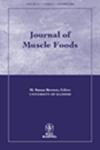MOLECULAR AND BIOLOGICAL FACTORS AFFECTING SKELETAL MUSCLE CELLS AFTER SLAUGHTERING AND THEIR IMPACT ON MEAT QUALITY: A MINI-REVIEW
Abstract
ABSTRACT
The postmortem factors like rate of glycolysis and muscle shortening have a major role on meat characteristics and these have been efficiently manipulated by methods like chilling regime, electrical stimulation and different hanging. These methods have been optimized with time leaving a little scope for further improvement. During the harvesting process of meat there is a generalized cell death often referred to as necrosis or apoptosis. This process of cell death has been well studied with respect to various physiological functions in vivo but its role in postmortem meat quality has received little attention. It is mainly regulated by caspases and also probably by calpains, cathepsins, proteasomes, lysosomal enzymes and other molecules, antioxidants and stress proteins. The term apoptosis appears to be more appropriate as evident by involvement of the enzyme systems and cell shrinkage. Further, examination of postmortem events effecting meat quality and correlating them to understand the cell death process may reveal the possible involvement of both apoptosis and necrosis processes, one preceding the other. This manuscript is an attempt to review the apoptotic process of various cell lines and possible implication for muscle cells after slaughter and meat quality control.
PRACTICAL APPLICATIONS
Understanding the intricate biochemical mechanisms governing cell death processes after slaughter may help us provide better solutions for pre-slaughter animal handling and postslaughter interventions to manage meat toughness. Investigations on these tracks would distinguish muscle cell death processes after slaughter from apoptosis or necrosis, and consequently may lead to enhanced technological meat quality as available literature suggests that a number of molecules such as caspase family are likely to be involved in cell death process after slaughter and also in meat tenderization.

 求助内容:
求助内容: 应助结果提醒方式:
应助结果提醒方式:


